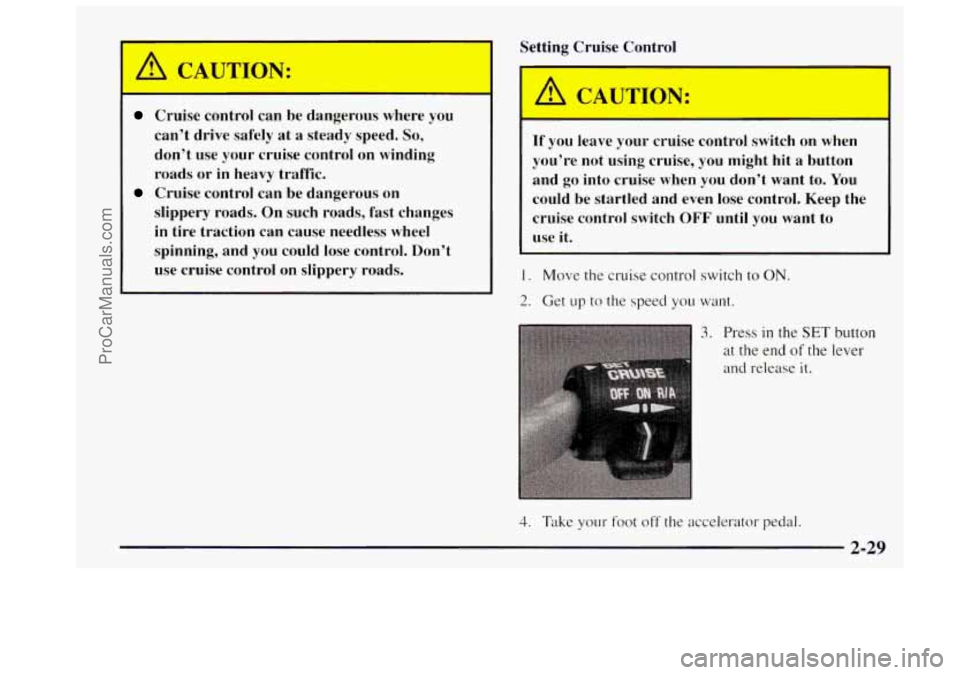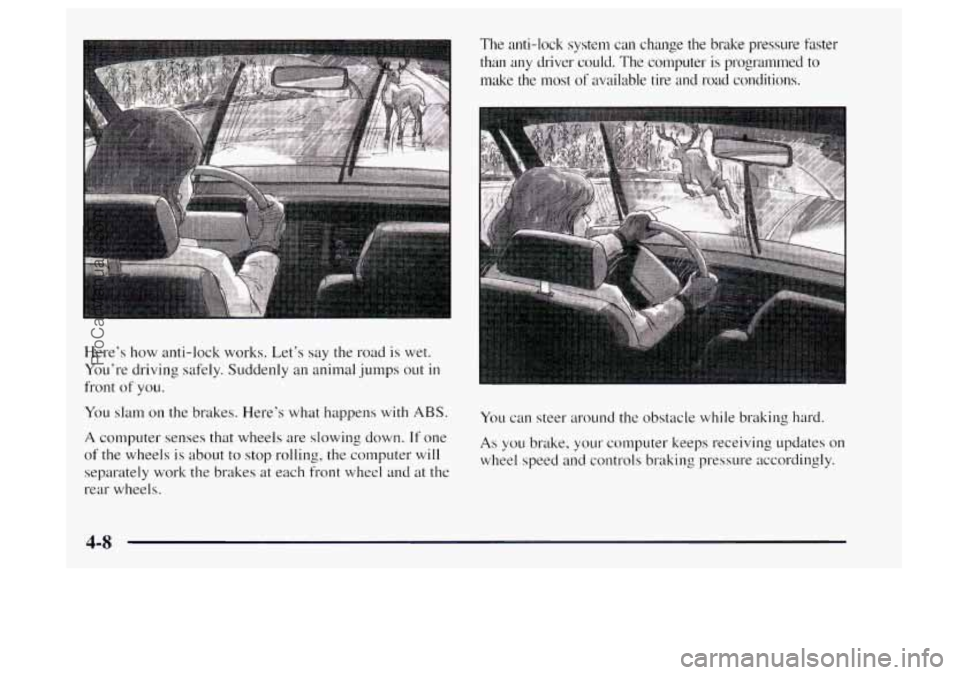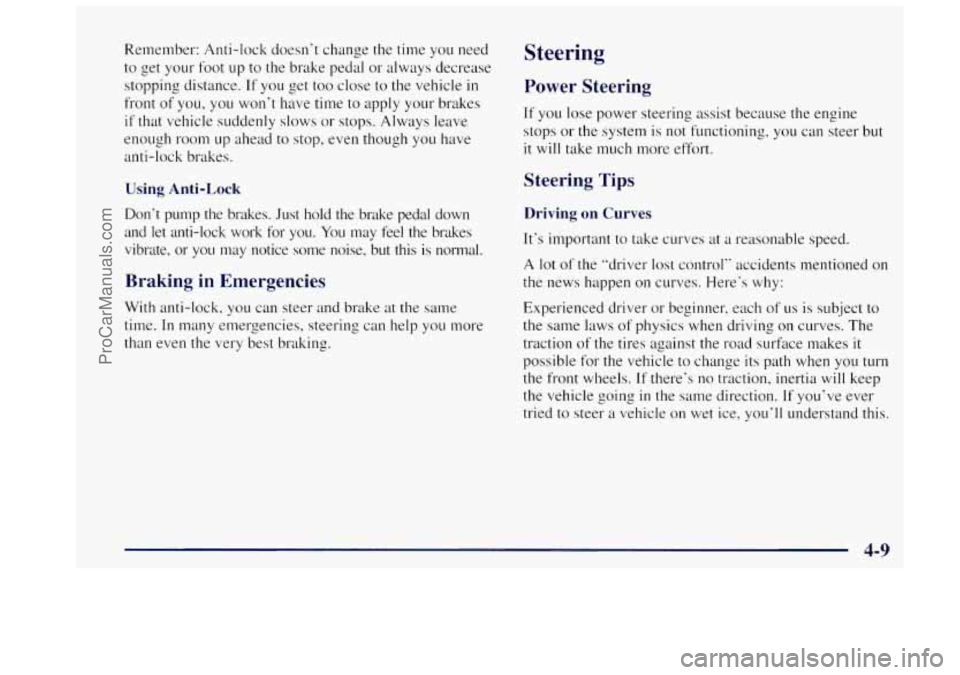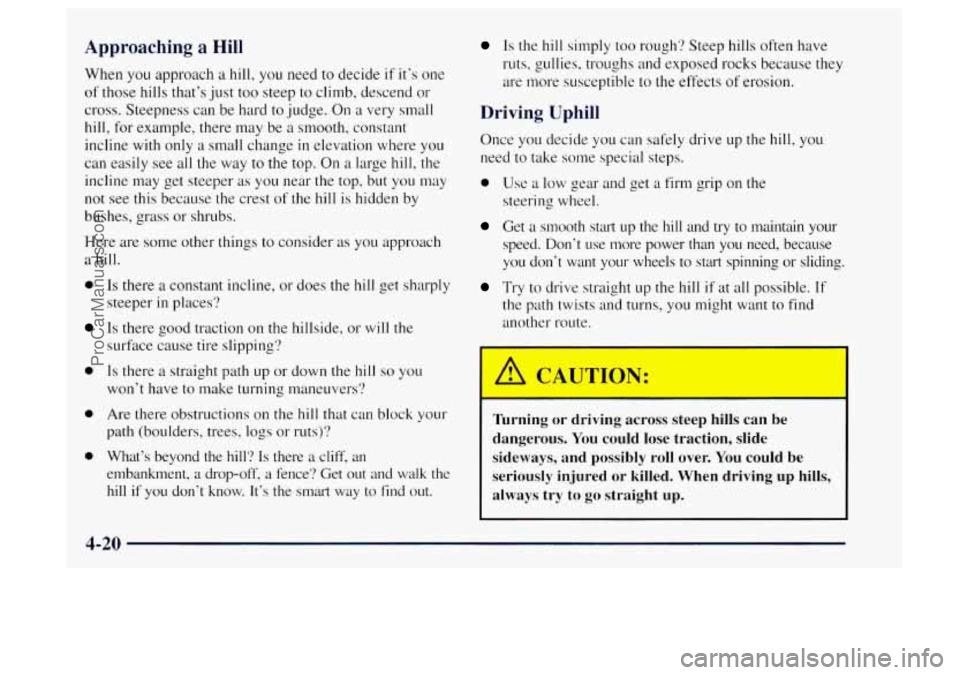1997 OLDSMOBILE BRAVADA change wheel
[x] Cancel search: change wheelPage 55 of 358

a Section 2 Features and Controls
Here you can learn about the many standard and optional features on your Oldsnwbile, and information on starting,
shifting and braking. Also explained are the instrument panel and the warning systems that tell you
if everything is
working properly
-- and what to do if you have a problem.
2-2
2 -4
2-5
2-6
2-7
2-
IO
2-1 1
2- 12
2-13
2-
14
2-15
2-18
2-22
2-34 Important Information
About Keys
Door Locks
Operation of Child Security Locks
Remote Keyless Entry
Battery Replacement for RKE
Preventing
Theft of Your Vehicle
New Vehicle "Break-In"
Ignition Positions
Tips
on Starting Your Engine
Using the Engine Coolant Heater
Automatic Transmission Operation
Parking Brake Guidelines
Important Information
on Engine Exhaust
Operation of Your Windows 2-2s
2-25
2-26
2-27
2-28
2-3
1
2-32
2-33
2-34
2-35
2-48 2-52
Adjusting the Tilt Steering Wheel
Functions
of the Multifunction Lever
How
to Use the HighLow Beam
Headlamp Changer
Windshield Wipers and Fluid
Using Cruise Control
Exterior Lamps Daytime Running Lamps (DRL)
Rearview Mirrors
Storage Compartments
Instrument Panel Overview
All About Your Warning Lights and Gages
Interior
Lamps
ProCarManuals.com
Page 79 of 358

Tilt Wheel
You should adjust the
steering wheel before
you drive.
You can raise it to the highest level to give your legs
more room when you enter and exit the vehicle.
To tilt the wheel, hold the steering wheel and pull the
lever toward you. Move the steering wheel to a
comfortable level, then release the lever
to lock the
wheel in place.
Do not adjust the steering wheel while driving.
Turn SignaVMultifunction Lever
The lever on the left side of the steering column
includes your:
Turn Signal and Lane Change Indicator
Headlamp HighLow Beam Changer
Windshield Wipers
Windshield Washer
0 Cruise Control
2-25
ProCarManuals.com
Page 83 of 358

A CAUTIO .:
Cruise control can be dangerous where you
can’t drive safely at a steady speed. So,
don’t use your cruise control on winding
roads or in heavy traffic.
slippery roads. On such roads, fast changes
in tire traction can cause needless wheel
spinning, and you could lose control. Don’t
use cruise control on slippery roads.
Cruise control can be dangerous on Setting Cruise Control
If you
leave your cruise control switch on when
you’re not using cruise, you might hit a button
and go into cruise when you don’t want to. You
could be startled and even lose control. Keep the
cruise control switch
OFF until you want to
use
it.
1. Move the cruise control switch to ON.
2. Get up to the speed you want.
3. Press in the SET button
at the end
of the lever
and release it.
4. Take your foot off the accelerator pedal.
ProCarManuals.com
Page 140 of 358

Here’s how anti-lock works. Let’s say the road is wet.
You’re driving safely. Suddenly an animal jumps out
in
front of you.
You slam
on the brakes. Here’s what happens with ABS.
A computer senses that wheels are slowing down. If one
of the wheels is about to stop rolling, the computer
will
separately work the brakes at each front wheel and at the
rear wheels. The anti-lock system can change the brake
pressure faster
than any driver could. The computer is programmed to
make the most of available tire and road conditions.
You can steer around the obstacle while braking hard.
As you brake, your cornputer keeps receiving updates on
wheel speed and controls braking pressure accordingly.
4-8
ProCarManuals.com
Page 141 of 358

Remember: Anti-lock doesn’t change the time you need
to get your foot
up to the brake pedal or always decrease
stopping distance.
If you get too close to the vehicle in
front of you, you won’t have time to apply your brakes
if that vehicle suddenly slows or stops. Always leave
enough room up ahead to stop, even though you have
anti-lock brakes.
Using Anti-Lock
Don’t pump the brakes. Just hold the brake pedal down
and let anti-lock work for you.
You may feel the brakes
vibrate, or you may notice some noise, but this is normal.
Braking in Emergencies
With anti-lock, you can steer and brake at the same
time.
In many emergencies, steering can help you more
than even the very best braking.
Steering
Power Steering
If you lose power steering assist because the engine
stops or the system is
not functioning, you can steer but
it will take much more effort.
Steering Tips
Driving on Curves
It’s important to take curves at a reasonable speed.
A lot of the “driver lost control” accidents mentioned on
the news happen on curves. Here’s why:
Experienced driver or beginner, each
of us is subject to
the same laws of physics when driving
on curves. The
traction
of the tires against the road surface makes it
possible for the vehicle to change its path when you turn
the front wheels.
If there’s no traction, inertia will keep
the vehicle going in the same direction.
If you’ve ever
tried to steer a vehicle on wet ice,
you’ll understand this.
ProCarManuals.com
Page 146 of 358

Loss of Control
Let’s review what driving experts say about what
happens when
the three control systems (brakes, steering
and acceleration) don’t have enough friction where the
tires meet the road to do what the driver has asked.
In any emergency, don’t give up. Keep trying to steer and
constantly seek an escape route or area of less danger.
Skidding
In a skid, a driver can lose control of the vehicle.
Defensive drivers avoid most skids by taking reasonable
care suited
to existing conditions, and by not “overdriving”
those conditions. But skids are always possible.
The three types of skids correspond to your
Oldsmobile’s three control systems. In the braking skid,
your wheels aren’t rolling.
In the steering or cornering
skid, too much speed or steering in a curve causes tires
to slip and lose cornering force. And
in the acceleration
skid, too much throttle causes the driving wheels
to spin.
A cornering skid and an acceleration skid are best
handled by easing your foot off the accelerator pedal.
If your vehicle starts to slide, ease your foot off the
accelerator pedal and quickly steer the way you want the
vehicle to go. If you start steering quickly enough, your
vehicle may straighten out. Always be ready for
a
second skid if it occurs.
Of course, traction
is reduced when water, snow, ice,
gravel or other material is on the road. For safety, you’ll
want
to slow down and adjust your driving to these
conditions.
It is important to slow down on slippery
surfaces because stopping distance will be longer and
vehicle control more limited.
While driving on a surface with reduced traction, try
your best to avoid sudden steering, acceleration or
braking (including engine braking by shifting to a lower
gear).
Any sudden changes could cause the tires to slide.
You may not realize
the surface is slippery until your
vehicle is skidding. Learn to recognize warning
clues
-- such as enough water, ice or packed snow on
the road to make a “mirrored surface” -- and slow
down
when you have any doubt.
Remember:
Any anti-lock brake system (ABS) helps
avoid only the braking skid.
4-14
ProCarManuals.com
Page 150 of 358

Cont.rolling your vehicle is the key to successful
off-road driving. One
of the best ways to control your
vehicle is to control your speed. Here are some things to
keep
in mind. At higher speeds:
0 you approach things faster and you have less time to
scan the terrain for obstacles.
0 you have less time t.o react.
0 you have more vehicle bounce when you drive
over obstacles.
0 you‘ll need more distance for braking, especially
since you’re on an unpaved surface.
When you’re driving off-road, bouncing and
quick changes in direction can easily throw you
out of position. This could cause you to lose
control and crash.
So, whether you’re driving on
or off the road, you and your passengers should
wear safety be1t.s.
Scanning the Terrain
Off-road driving can take you over many different kinds
of terrain.
You need to be familiar with the terrain and
its many different features. Here are some things
to consider.
Slrrjji~~~ Cn1~tlitio~7.s. Off-roading can take you over
hard-packed
dirt, gravel, rocks, grass, sand, mud, snow
or ice. Each of these surfaces affects the steering,
acceleration and braking
of your vehicle in different
ways. Depending upon the kind of surface you are on,
you may experience slipping, sliding, wheel spinning,
delayed acceleration, poor traction and longer
braking distances.
Su~jircc. O6st~trcI~.s.. Unseen or hidden obstacles can be
hazardous. A rock,
log, hole, rut or bump can startle you if
you’re not prepared for them. Often these obstacles are
hidden by
grass, bushes, snow or even the rise and fall of
the terrain itself-’. Here are some things to consider:
0 Is the path ahead clear?
0 Will the surface texture change abruptly up ahead?
0 Does the travel take you uphill or downhill? (There’s
more discussion
of these subjects later.)
Will you have to stop suddenly or change
direction quickly?
ProCarManuals.com
Page 152 of 358

Apm I ~ ~ ~ hing a Hill
When you approach a hill, you need to decide if it’s one
of those hills that’s just too steep to climb, descend or
cross. Steepness can be hard to judge. On a very small
hill, for example, there may be a smooth, constant
incline with only
a small change in elevation where you
can easily see all the way to the top. On a large hill, the
incline may get steeper as you near the top, but you may
not see this because the crest of the hill is hidden by
bushes, grass or shrubs.
Here are some other things to consider as you approach
a hill.
0 Is there a constant incline, or does the hill get sharply
steeper
in places?
Is there good traction on the hillside, or will the
surface cause tire slipping?
0 Is there a straight path up or down the hill so you
won’t have to make turning maneuvers?
0 Are there obstructions on the hill that can block your
path (boulders, trees, logs or ruts)?
0 What’s beyond the hill‘? Is there a cliff, an
embankment,
a drop-off, a fence? Get out and walk the
hill if you don‘t know, It’s the smart way to find out.
Is the hill simply too rough? Steep hills often have
ruts, gullies, troughs and exposed rocks because they
are more susceptible to the effects
of erosion.
Driving Uphill
Once you decide you can safely drive up the hill, you
need to take
some special steps.
0 Use a low gear and get a firm grip on the
steering wheel.
Get a smooth start up the hill and try to maintain your
speed. Don’t use more power than you need, because
you don’t want your wheels to start spinning or sliding.
Try to drive straight up the hill if at all possible. If
the path twists and turns, you might want to find
another route.
Turning or driving across steep hills can be
dangerous. You could lose traction, slide
sideways, and possibly roll over. You could be
seriously injured or killed. When driving up hills,
always try to go straight up.
4-20
ProCarManuals.com